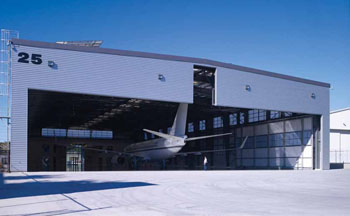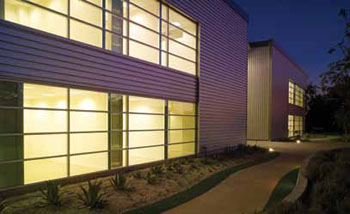
Hangar 25 -The first hangar to achieve LEED platinum certification


D.O.M. magazine’s cover story has traditionally been a profile of a director of maintenance or other aviation maintenance manager. This month we are straying a little from tradition and profiling a hangar. No, not just any hangar. This is Hangar 25 at Bob Hope airport in Burbank, CA. Avjet and Shangri-La Construction partnered to build Hangar 25. They pushed the boundaries of design and engineering to build a “green” hangar unlike any other hangar designed before.
Known as “the most sustainable airplane hangar in the world,” Hangar 25 opened in December, 2008 and is the world’s first hangar to achieve platinum certification under the U.S. Green Building Council’s Leadership in Energy and Environmental Design (LEED) rating system. Hangar 25 isn’t just a building that houses aircraft, people and maintenance operations — it’s an energy-producing asset. This month, D.O.M. takes a look at some of the technologies incorporated into the hangar and offers tips for maintenance managers considering going green in their next hangar design.
Energy Production
It all starts with energy production. Mounted atop Hangar 25’s roof are 1,530 solar panels. The panels take advantage of southern California’s abundant sunshine and generate 225 kW of photovoltaic energy. This power generation provides 110 percent of the hangar’s energy needs. All hangar equipment including tow tractors, ground power units, boom and scissor lifts, forklifts, golf carts, boarding stairs, lavatory servicing units and ground air conditioning units are electrically powered. Since the hangar produces more energy than it uses, excess energy is sent to the Burbank power grid, providing clean energy for an estimated 50 homes.

Efficient design
Photovoltaic energy production would be insufficient to meet the needs of an aviation maintenance facility if significant energy-saving designs weren’t incorporated into the hangar itself. Here are some of the design features built into Hangar 25.
Roof Shielding
In addition to generating power, the photovoltaic panels mounted on the roof provide shade to more than 50 percent of the roof surface, significantly reducing radiant heat gain to the roof. Radiant heat gain is further reduced by the bright white surface of the roof. “Swamp coolers” (misting fans) and plants were also incorporated to offer additional cooling.

Interior Cooling
Traditional refrigerant-based cooling units consume a lot of energy. Although office spaces in Hangar 25 are able to be cooled efficiently using roof-mounted air conditioning units, It’s not an option for cooling the hangar space itself. For that job, seven Big Ass Fans were installed. The fans reduce the temperature of the hangar by 10-15 degrees. In colder weather, the fans are run at slower speeds to evenly distribute warm air to the area.
 Lighting
Lighting
Natural lighting is utilized in 95 percent of the building, practically eliminating the need for artificial lighting during the daytime. In office spaces large windows, open spaces, and light-colored floors distribute natural light. In the hangar, skylights and the floor combine to provide an abundance of natural lighting. For those areas that require artificial lighting (like bathrooms and storage closets), sensors are used to turn the lights on and off.
The Hangar Floor
When Avjet and Shangri-La were looking at hangar floor coating options, they first looked to epoxy coating. “We were looking at epoxy floors because we thought diamond-polished concrete was going to be much more expensive, and we were trying to keep construction at a traditional cost,” shares Jennifer Berthelot-Jelovic, director of sustainability for Shangri-La. “We broke down the cost of having to replace an epoxy coat every four to five years. We also looked at the cost for diamond-polished floors which would need nothing but soap and water cleaning for the next 20 years. It actually worked out to be more cost-effective to install the diamond-polished floor. An added benefit is that the high-gloss polished-concrete reflects the light coming in from the skylights, increasing the amount of ambient light the mechanics have to work with.”
Other Green Innovations
Other green innovations that were incorporated into
Hangar 25 include:
Plumbing that reduces water use by 60 percent utilizing low-flush, low-flow and waterless fixtures.
Sustainable landscaping that uses drought-tolerant native plants like agave and cacti on a drip system to reduce water usage and prevent runoff. In addition, artificial lawns that require no mowing or watering were installed.
A state-of-the-art Hi-Fog fire suppression system was installed. It uses a reduced amount of water to suppress fires rather than a toxic foam system or traditional water suppression system using considerably larger amounts of water.
The Cost to Construct
Even with all the leading-edge designs incorporated into Hangar 25, the project still cost relatively the same as a “traditional” hangar would have. But unlike a traditionally-constructed hangar, Hangar 25 generates revenue, providing clean energy to the Burbank power grid.

Going green?
What tips would Jennifer offer to someone considering building a green aviation maintenance facility? First, she suggests involving someone with experience in sustainability and LEED certification. “I would suggest looking for a LEED Accredited Professional (AP) to help you out. But be careful. When we started the design process, we hired a LEED AP that hadn’t worked on any projects. She had taken the tests, but had no practical experience. There are a lot of LEED APs who can pass the test but don’t have any field experience. Do your due diligence to ensure the person you are relying on is experienced and knows what he or she is doing.”
Another tip Jennifer offers is to involve the whole team right from the beginning. “Make sure the entire team is on board from the start. We make it a design build process and make sure everyone is on board before we begin building — from the general contractor to the owner to the architect to the sub-contractors. We want everyone involved as part of the design phase so they can bring up issues before anything’s been purchased or before money has been spent. We find that when we spend more time in the design phase we are able to do our green builds at traditional costs because we don’t have mistakes or we don’t need to step backwards and try to figure out where we went wrong.”
If you like to learn more about the Hangar 25 project, you can visit www.hangar25.com. If you are going to be in the Burbank area and you would like to tour Hangar 25, you can contact Jennifer Berthelot-Jelovic at (310) 492-4407.
